Night Vision Camera Market Size
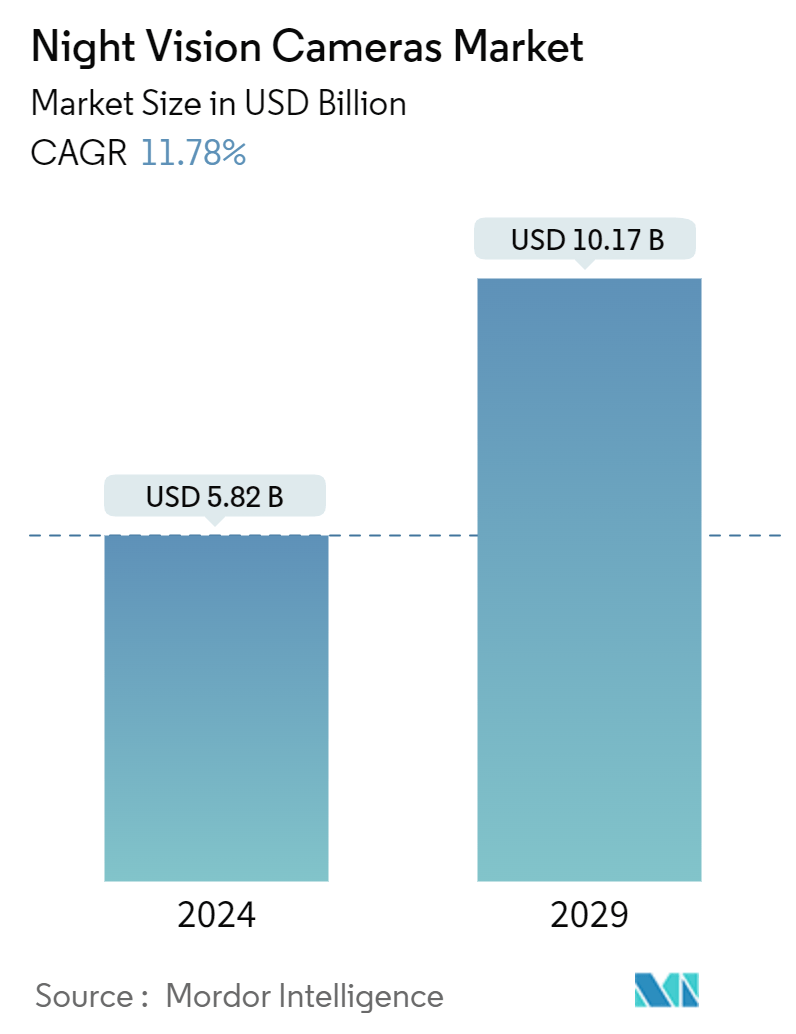
| Study Period | 2019 - 2029 |
| Market Size (2024) | USD 5.82 Billion |
| Market Size (2029) | USD 10.17 Billion |
| CAGR (2024 - 2029) | 11.78 % |
| Fastest Growing Market | Asia Pacific |
| Largest Market | North America |
Major Players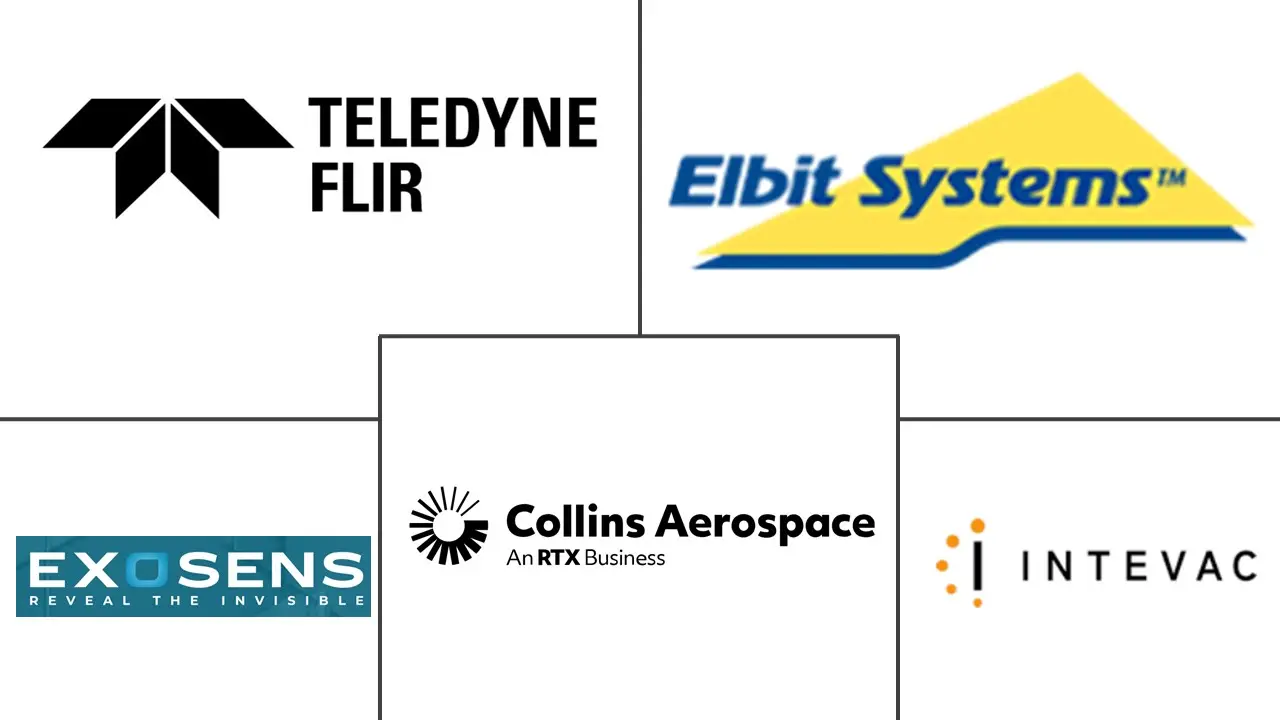
*Disclaimer: Major Players sorted in no particular order |
Night Vision Camera Market Analysis
The Night Vision Cameras Market size is estimated at USD 5.82 billion in 2024, and is expected to reach USD 10.17 billion by 2029, growing at a CAGR of 11.78% during the forecast period (2024-2029).
Night vision cameras are essential for enhancing the efficiency of a video surveillance system in low-light situations. The key characteristic that combines all these cameras is the inclusion of IR illumination, which is crucial for conducting video surveillance during nighttime.
Night vision cameras safeguard valuable assets by capturing video evidence of vandalism, theft, and unauthorized activities in low-light conditions. Most standard security systems or cameras often fail to fulfill this task. Advanced night vision security cameras enable an impressive array of features to make after-hours video surveillance easy, efficient, and accurate. They are one of the fastest-growing security systems in the global market. As a result, these cameras are being preferred across various industries and, in some cases, by several individuals for residential, public infrastructure, and industrial applications.
Advanced night vision security cameras offer a wide range of functions to simplify, streamline, and enhance video surveillance during nighttime hours. They have become one of the most rapidly expanding security solutions worldwide. Consequently, these cameras are gaining popularity in different sectors and, in certain instances, among numerous individuals for home, public facility, and industrial uses. Moreover, governments are prioritizing night vision features for their intelligent camera setups.
Night vision cameras are increasingly used for automobiles in the civilian market. In bad weather conditions or at night, automotive night vision systems can increase a driver's perception and viewing distance. Typically, they capture data via infrared or thermal imaging, occasionally paired with active illumination techniques, and then show it to the driver. Night vision has also been used in aircraft and helicopters, low-light hunting, and night shooting competitions.
These night-vision systems are subjected to challenging battlefield circumstances and extensive military use. The expense of replacing and maintaining a night vision gadget is prohibitively expensive. Refurbishment, repair, or upgrade is a low-cost alternative solution. The increased prices of near-vision device systems relate to practical and durable hardware. As an image tube can cost millions of dollars to develop, build, and install, the equipment contains a more significant capital expenditure necessary to invest in it. Due to the sensitivity of the cooled infrared detector system, cooled thermal imaging cameras give the best image quality and the most significant variation in ambient temperature. Still, the cooling systems have a limited lifetime.
The night vision cameras market was impacted significantly due to the outbreak of COVID-19 as the supply chain disruption due to travel restrictions and labor shortage issues influenced manufacturers' production capabilities. However, the upliftment of COVID-19-led restrictions eased the supply chain issues, helping the manufacturers of night vision cameras expand their production capabilities.
Apart from the pandemic influencing the demand and supply chain, it also led to the emergence of new use cases of night vision cameras, which is anticipated to support the market's growth post-COVID-19. For instance, during the pandemic, the South Diego Chula Vista Police Department announced an investment of over USD 11,000 to acquire two drones equipped with night vision cameras to mitigate the risk to the officers in these areas. The department mentioned that it aimed to watch over people living on the streets with these drones amid the outbreak.
Night Vision Camera Market Trends
The Military and Defense Segment is Expected to Hold Significant Market Share
- Night vision cameras are crucial gadgets of armed forces, and most modern armies equip each of their soldiers with these devices. Night vision aids military forces in defending an area or scanning for threats, such as tanks or persons wishing to harm them. As to how the light reflects off the landscape, everything appears to have a greenish hue while utilizing these devices.
- The increase in terrorist activities, political tensions related to border disputes, and concerns regarding security and safety have led to a significant rise in the need for night vision cameras within the military industry. Military and defense organizations are continuously improving their capabilities by incorporating night vision cameras to address the escalating demand for night-time surveillance and combat missions. The ongoing conflict between Russia and Ukraine has also prompted many nations to boost their defense budgets, potentially benefiting the market's expansion.
- There is an increased demand for night vision cameras for operations by the military industry and during warfare activities. Countries such as China, India, Japan, and South Korea are investing to incorporate technological innovations in these devices. Several manufacturers are incorporating high-quality materials and modern technology to offer night vision goggles and cameras that are both highly durable and functional.
- SWIR or short-wavelength infrared night vision camera systems are also used for vehicle navigation. Military ground transport vehicles such as trucks, tanks, and armored personnel carriers are required to operate in complete darkness, increasing the demand for enhanced vision systems (EVS) with short-wave infrared (SWIR) illumination and sensors. Infinite short-wave infrared night vision camera systems are used to maneuver discreetly through dangerous territories. SWIR cameras, unlike MWIR and LWIR, can image through the windshield, allowing them to be positioned in the driver's compartment for a "driver's eye" view of the road ahead. Ruggedized outside housings can also accommodate SWIR cameras.
- According to NATO, the United States was expected to spend an estimated USD 860.00 billion on defense in 2023. As a result, the country's defense spending was the largest among NATO countries. The United Kingdom recorded the second biggest defense spending, at USD 65.76 billion, Germany at USD 68.08 billion, and France at USD 56.64 billion. Such investments are anticipated to propel the growth of the night vision cameras market in the military and defense industry during the forecast period.
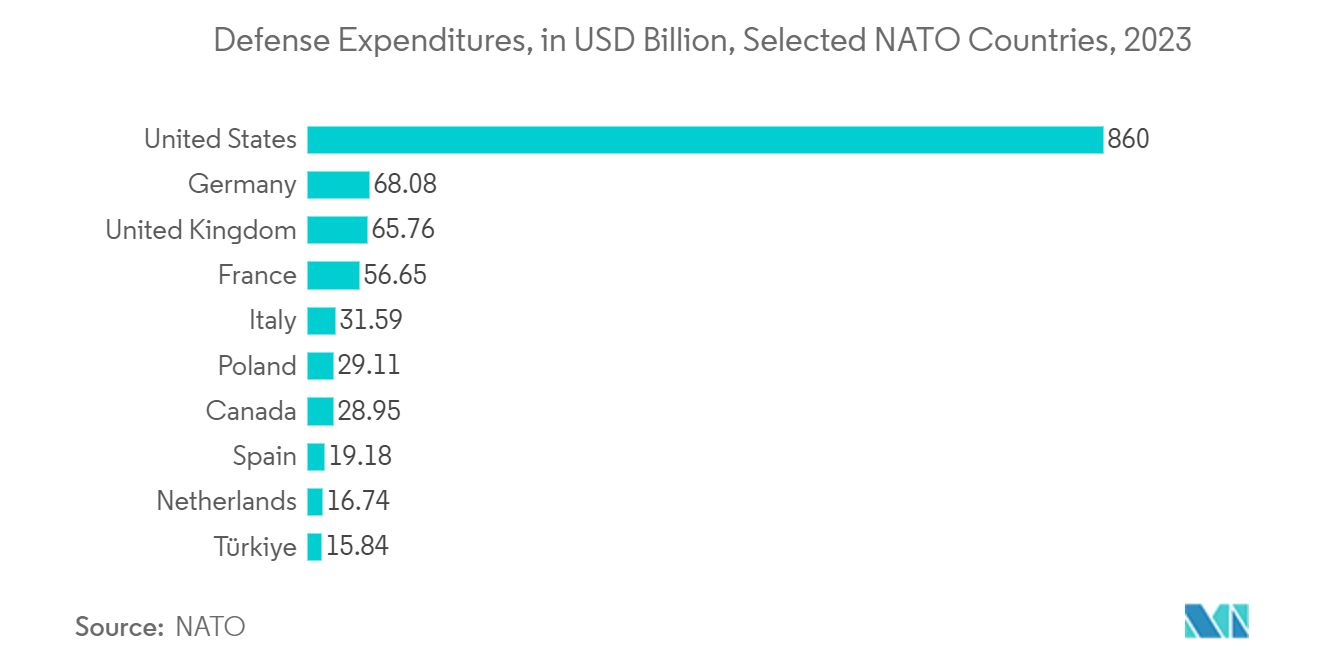
Asia-Pacific is Expected to Witness Significant Growth
- The night vision cameras market is expected to grow significantly in Asia-Pacific, owing to rising government spending on defense infrastructure for enhanced personnel capabilities. Furthermore, with the development of new technologies, the cost of night vision devices is expected to reduce, enabling increased spending by the end users.
- With the region's vast variation in military and defense expenditure, the market studied is expected to flourish. Night vision cameras would help countries in the region to advance their military devices and technology. According to SPIRI, military spending in Asia increased from around USD 204 billion in 2000 to approximately USD 595 billion in 2023, nearly three times the amount spent in 2000.
- Companies in the region are launching new night vision cameras. Security is a significant concern that has given rise to an increased demand for security and surveillance equipment with high-end features and economical pricing.
- For instance, in January 2024, Consistent Infosystems, an Indian IT brand, introduced its new range of Made in India surveillance cameras that offer complete surveillance solutions. The cameras offered by the company include the Smart Wireless 4G PT Camera, 4G Solar Camera, Wireless Pan-Tilt Wi-Fi 3MP/4MP Mini Wi-Fi P2P Plug and Play, 4G Color Camera, and CCTV Camera 4G Dome. The company's extensive range of surveillance cameras and network video recorders (NVRs) are packed with advanced features, such as smart Wi-Fi app control and night vision, which help users communicate with anyone on the other end of the cameras and get clear footage even in low-light conditions.
- Such developments and advancements in night vision cameras in the region may increase the adoption of the devices by various end users, thus propelling the growth of the market studied.
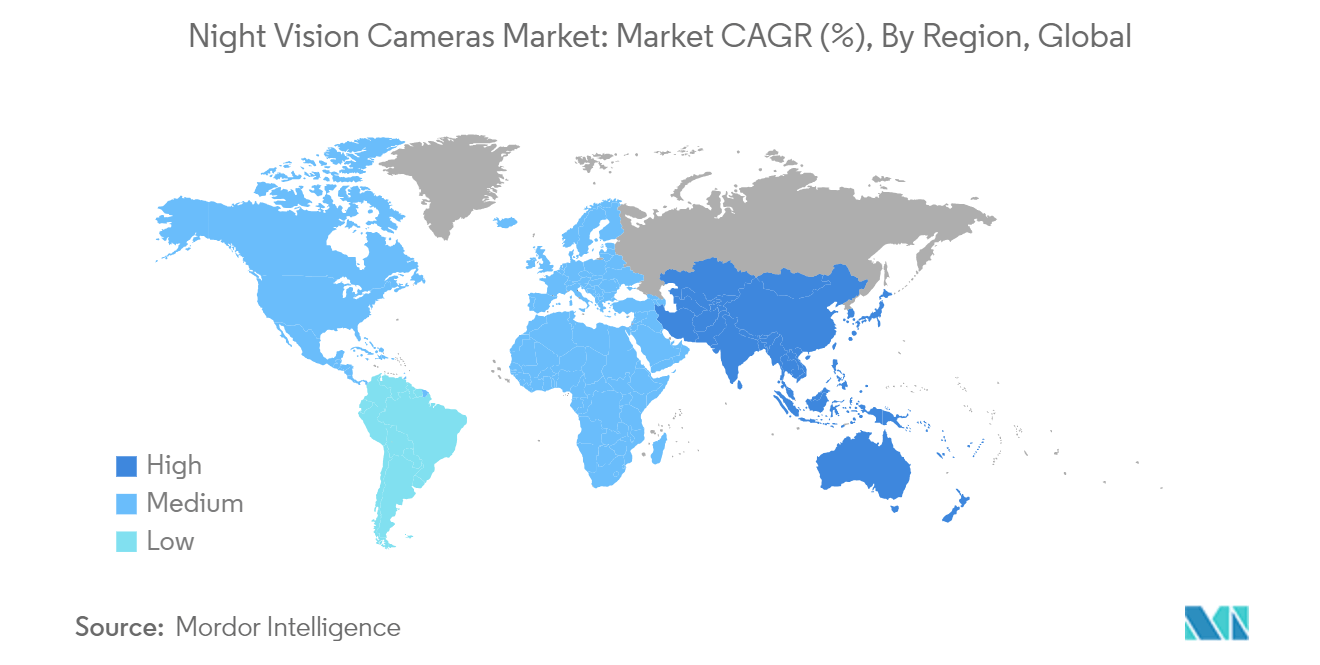
Night Vision Camera Industry Overview
The night vision cameras market is fragmented due to the presence of both global players and small and medium-sized enterprises. Some of the major players in the market are Intevac Inc., Photonis (Exosens), Elbit Systems Ltd, Rockwell Collins Inc., and FLIR Systems Inc. Players in the market are adopting strategies, such as partnerships and acquisitions, to enhance their product offerings and gain sustainable competitive advantage.
- In February 2024, BAE Systems PLC acquired Ball Aerospace, a defense technology and tactical missiles company, offering highly relevant mission-critical capabilities for customers' future needs.
- In January 2024, Valeo and Teledyne FLIR announced an agreement and contract for thermal imaging for automotive safety systems. The collaboration brings together Valeo, the leader in automotive camera technologies, with Teledyne FLIR. The companies are expected to deliver the first automotive safety integrity level (ASIL) B thermal imaging technology for night vision ADAS. This system is projected to complement Valeo's large range of sensors and rely on Valeo's ADAS software stack to support functions such as automatic emergency braking (AEB) at night for passenger and commercial vehicles and autonomous cars.
- In September 2023, Photonis Group, one of the global leaders in highly differentiated technology for detection, imaging, and light, acquired four companies (Xenics, Proxivision, Telops, and Elmul). Being a global leader in image intensifier tubes, the company diversified its technologies and product portfolios to become the global leader in detection and imaging technologies. Photonis Group became Exosens to illustrate that strategy.
Night Vision Camera Market Leaders
-
Intevac Inc.
-
Photonis (Exosens)
-
Elbit Systems Ltd
-
Rockwell Collins Inc.
-
FLIR Systems Inc.
*Disclaimer: Major Players sorted in no particular order
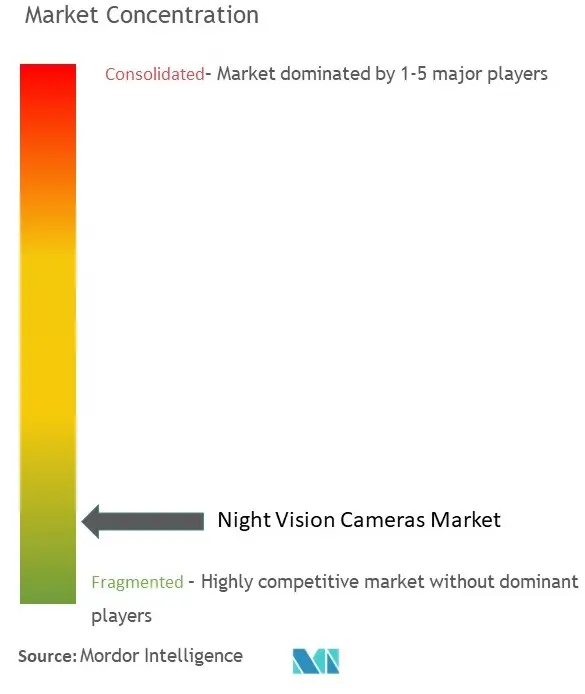
Night Vision Camera Market News
- February 2024 - Hanwha Vision ushered in a fresh era of accuracy and security in vital sectors through its state-of-the-art, AI-driven radiometric thermal camera series. These advanced devices go beyond conventional security measures by integrating advanced artificial intelligence with temperature detection and high-performance imaging, resulting in unmatched solutions for various applications. AI-based radiometric thermal cameras excel in piercing through darkness and inclement weather, ensuring clear visuals for safe navigation and docking, particularly in nighttime or low-visibility scenarios.
- January 2024 - Deep Sentinel, a security provider, launched its new DS2 wireless security camera system with a superior AI model, higher video resolution, and color night vision. Homes without a security and surveillance system face a higher risk of burglary, thereby increasing the need for innovative, reliable security solutions.
- December 2023 - Thales and the Spanish security company Trablisa formed a joint venture to complete the installation of an integrated surveillance system in the Melilla Command of the Civil Guard for intelligent border control. The surveillance system will enable the Civil Guard with high-resolution day and night cameras. The night vision cameras and the monitoring and control software (HORUS) allow the centralized management and control of sensors and actuators as well as the processing of images.
Night Vision Camera Market Report - Table of Contents
1. INTRODUCTION
- 1.1 Study Assumptions and Market Definition
- 1.2 Scope of the Study
2. RESEARCH METHODOLOGY
3. EXECUTIVE SUMMARY
4. MARKET DYNAMICS
- 4.1 Market Overview
- 4.2 Industry Value Chain Analysis
-
4.3 Industry Attractiveness - Porter's Five Forces Analysis
- 4.3.1 Threat of New Entrants
- 4.3.2 Bargaining Power of Buyers/Consumers
- 4.3.3 Bargaining Power of Suppliers
- 4.3.4 Threat of Substitute Products
- 4.3.5 Intensity of Competitive Rivalry
5. MARKET INSIGHTS
- 5.1 Introduction to Market Drivers and Restraints
-
5.2 Market Drivers
- 5.2.1 Rising Need for Advanced Surveillance Technology
- 5.2.2 Automotive Night Vision Applications
-
5.3 Market Restraints
- 5.3.1 Targetting through Transparent Obstacles
6. MARKET SEGMENTATION
-
6.1 By Type
- 6.1.1 Wired Night Vision Cameras
- 6.1.2 Wireless Night Vision Cameras
-
6.2 By End User
- 6.2.1 Military and Defense
- 6.2.2 Industrial
- 6.2.3 Public and Residential Infrastructure
- 6.2.4 Transportation
- 6.2.5 Research
- 6.2.6 Other End Users
-
6.3 By Geography***
- 6.3.1 North America
- 6.3.2 Europe
- 6.3.3 Asia
- 6.3.4 Australia and New Zealand
- 6.3.5 Latin America
- 6.3.6 Middle East and Africa
7. COMPETITIVE LANDSCAPE
-
7.1 Company Profiles*
- 7.1.1 Intevac Inc.
- 7.1.2 Photonis (Exosens)
- 7.1.3 Elbit Systems Ltd
- 7.1.4 Rockwell Collins Inc.
- 7.1.5 FLIR Systems Inc.
- 7.1.6 Panasonic Corporation
- 7.1.7 BAE Systems PLC
- 7.1.8 TAK Technologies Private Limited
- 7.1.9 Harris Corporation
- 7.1.10 Tactical Night Vision Company Inc.
- 7.1.11 General Dynamics Global Imaging Technologies Inc.
- 7.1.12 Nivisys LLC
- 7.1.13 Sony Corporation
- 7.1.14 Sharp Corporation
8. INVESTMENT ANALYSIS
9. MARKET OPPORTUNITIES AND FUTURE TRENDS
** Subject To AvailablityNight Vision Camera Industry Segmentation
Night vision cameras are used to intensify human sight under very low light conditions. The market is segmented on the basis of technology and safety and security measures across different industries, such as manufacturing, services, transportation, military and defense, and automobile.
The night vision cameras market is segmented by type (wired night vision cameras, wireless night vision cameras), end user (military and defense, industrial, public and residential infrastructure, transportation, and research), and geography (North America, Europe, Asia-Pacific, and Rest of the World). The report offers market sizes and forecasts in terms of value (USD) for all the above segments.
| By Type | Wired Night Vision Cameras |
| Wireless Night Vision Cameras | |
| By End User | Military and Defense |
| Industrial | |
| Public and Residential Infrastructure | |
| Transportation | |
| Research | |
| Other End Users | |
| By Geography*** | North America |
| Europe | |
| Asia | |
| Australia and New Zealand | |
| Latin America | |
| Middle East and Africa |
Night Vision Camera Market Research FAQs
How big is the Night Vision Cameras Market?
The Night Vision Cameras Market size is expected to reach USD 5.82 billion in 2024 and grow at a CAGR of 11.78% to reach USD 10.17 billion by 2029.
What is the current Night Vision Cameras Market size?
In 2024, the Night Vision Cameras Market size is expected to reach USD 5.82 billion.
Who are the key players in Night Vision Cameras Market?
Intevac Inc., Photonis (Exosens), Elbit Systems Ltd, Rockwell Collins Inc. and FLIR Systems Inc. are the major companies operating in the Night Vision Cameras Market.
Which is the fastest growing region in Night Vision Cameras Market?
Asia Pacific is estimated to grow at the highest CAGR over the forecast period (2024-2029).
Which region has the biggest share in Night Vision Cameras Market?
In 2024, the North America accounts for the largest market share in Night Vision Cameras Market.
What years does this Night Vision Cameras Market cover, and what was the market size in 2023?
In 2023, the Night Vision Cameras Market size was estimated at USD 5.13 billion. The report covers the Night Vision Cameras Market historical market size for years: 2019, 2020, 2021, 2022 and 2023. The report also forecasts the Night Vision Cameras Market size for years: 2024, 2025, 2026, 2027, 2028 and 2029.
Night Vision Cameras Industry Report
Statistics for the 2024 Night Vision Cameras market share, size and revenue growth rate, created by Mordor Intelligence™ Industry Reports. Night Vision Cameras analysis includes a market forecast outlook to 2029 and historical overview. Get a sample of this industry analysis as a free report PDF download.



